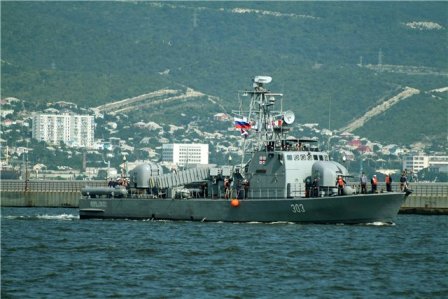Matka-class
Summary
| Origin country | 🇨🇳 Ex-USSR |
| Category | Patrol vessel |
| Subtype | Hydrofoil |
| Manufacturer | Izhora shipyards |
| Year commissioned | 1977 |
| Units | KOSAR, STUPINETS. U153 PRILUKI, U154 KAHOVKA |
Description
The Matka class, known as Project 206MR Vikhr to the Soviet Navy, represents a fleet of hydrofoil missile boats initially employed by the Baltic and Black Sea Fleets. Upon the dissolution of the Soviet Union and the subsequent Black Sea Fleet partition treaty in 1997, all Black Sea Fleet Matka class boats were transferred to the Ukrainian Navy.
Developed as successors to the Osa-class missile boat, the Matka class vessels are notably a heavily modified variant of the Turya-class torpedo boat. Boasting a single hydrofoil design, these vessels can hydroplane at the aft section when reaching high speeds. Designed with an emphasis on operational capability under different conditions, they are equipped with air conditioning and are NBC-sealed. They feature SS-N-2 launchers, similar to those on the Project 61MR ("Mod-Kashin")-class destroyers. Despite early indications of the class being sea-worthy, subsequent feedback suggested that the Soviet Navy found them to be cramped and top-heavy. Out of thirteen boats initially planned, twelve were completed in Leningrad, with one cancellation and another started but not finished.
Russia decommissioned several Matka class boats after the breakup of the USSR, with five going to Ukraine; one of these was later refurbished and transferred to Georgia. The R-44 has been a prominent vessel within this class for the Black Sea Fleet, notably being the first to carry the SS-N-25 "Switchblade" missile. It has since undergone multiple upgrades, including weapon system changes with the installment of the AK-630М1-2 Roy CIWS and the SP-521 combat data system.
The operational history of the Matka class saw a notable incident during the 2008 South Ossetia war when it was erroneously reported that the Georgian boat Tbilisi had been sunk by Russian forces. However, it was actually destroyed by Russian Airborne Troops while docked at the port of Poti, not at sea as initially believed. This class of boats is currently represented in active service by the Ukrainian Navy with one boat, the Pryluky, and previously included the now-sunk Tbilisi in the Border Police of Georgia.
The name "Matka," assigned by NATO, interestingly translates to "uterus" in Russian but is also associated with the meaning "queen" of an insect hive. This latter conotation aligns with the tradition of naming maritime vessels after insects, as seen in previous classes named Osa (wasp) and Komar (mosquito).
The class comprised twelve boats in total with the Ukrainian Navy retaining one boat in active service, and the Georgian Tbilisi having been transferred from Ukraine before it was sunk in 2008. The operational status of the remaining fleet members is categorized as either preserved, active, decommissioned, or sunk.
Technical specifications
| Matka | |
|---|---|
| Displacement | 260 tons |
| Range | 1000 km at 20 knots |
| Endurance | 5 days |
| Crew | 30 members |
| Width | 7.6 m (24.9 ft) |
| Length | 38.6 m (126.6 ft) |
| Propulsion | 3 M504 diesel engines with a power of 15,000 hp - 3 propellers |
| Armament | 2 SS-N-2 + 1 SA-N-5 (IV 1) + 1 76mm AK-176 gun + 1 30mm AK-630 gun |
| Maximum speed | 42 knots |
Photo of Matka class
